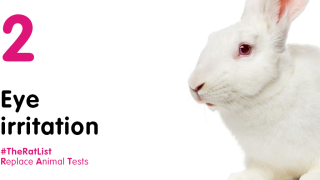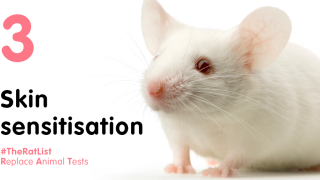Six animal tests that should no longer be taking place
It may be commonly assumed that those tests on animals which have non-animal replacements available are no longer conducted in the UK, or at least rarely. The reality is that such tests can persist, and even increase, long after the adoption of suitable alternative methods.
To draw attention to this issue, we created the Replace Animal Tests (RAT) list to highlight regulatory tests using animals that are still conducted in the UK despite having validated non-animal replacements.
The total number of animals still being used in these tests could be around 80,000 every year in the UK alone, based on statistics from 2022. Over the last 30 years there have been significant developments in the replacement of tests on animals used to meet legal requirements. Non-animal methods have been developed that can now replace, wholly or in part, a number of tests on animals across several product sectors.
However, our experience has been that actually replacing tests on animals takes much longer than it should. We have seen how valid non-animal methods for assessing skin irritation, skin sensitisation and batch safety have taken years to be accepted and we know that tests on animals are still being conducted to provide this type of information. This is unacceptable.
In many cases, the problem lies with lack of clarity from, and enforcement by, regulatory authorities, as well as the absence of a joined-up approach for acceptance of non-animal methods around the world. Since non-animal tests can be cheaper, faster and more accurate than the tests on animals they replace, it is in the interests of animal welfare and good science to speed up their acceptance and to expand their use.
Overcoming these remaining hurdles so that these tests on animals can be fully replaced is a matter of urgency.

Species: Rabbits
Number of tests in the UK: 0 – for the first time, no skin irritation tests were conducted on animals in 2022. We are keeping this test on our RAT list, however, because the Government has not ruled out that it could be conducted again in the future.
Product test is used for: Medical devices, chemicals and human medicines
Animal method: A test substance is applied to a 6 cm area of a rabbit’s shaved skin and held in place with a bandage for four hours. The rabbit is then examined for signs of skin damage for 14 days. If there are no signs of irritation, two more rabbits are used in a confirmatory test. Rabbits are singly housed and can suffer from painful skin reactions and rashes.
Replacement method: Reconstituted human skin models can be used to predict skin irritation in humans with more accuracy than the rabbit test.

Species: Rabbits
Number of tests in the UK: 3
Product test is used for: Medical devices, chemicals and human medicines
Animal method: A test substance is placed in the eyes of live rabbits and left for at least one hour before being washed out. Their eyes are then examined for signs of irritation and damage over three days. If there are no signs of severe irritation in the initial test, two more rabbits are used in a confirmatory test. Rabbits are singly housed and can experience painful damage in their eyes that can lead to blindness.
Replacement method: Reconstituted human eye models can be used to detect non-irritants. Eyes from hens and cows killed for food can also be used to identify severe irritants and non-irritants. Internationally agreed "Defined Approaches” have been developed which combine the use of different non-animal information sources – for example chemical-, computer- and cell-based tests – to enable evaluation of irritation severity without conducting new tests on animals.

Species: Mice
Number of tests in the UK: 248
Product test is used for: Chemicals, food and food contact materials
Animal method: A substance is applied to the ears of mice every day for three days. The mice are then killed three days later, and their ears are dissected.
Replacement method: Several chemical-, computer- and cell-based tests can be used to evaluate skin sensitisation, including in specific combinations known as “Defined Approaches”, as formalised in an internationally accepted guideline in 2021. Examples of non-animal tests include the direct peptide reactivity assay (DPRA), which measures the binding of a substance to proteins, the keratinocyte assay and the human Cell Line Activation Test (h-CLAT) which is based on human immune cells.

Species: Mice
Number of tests in the UK: 52,148*
Product test is used for: Human medicines
Animal method: Mice have an injection into their abdomens with botulinum toxin and, over the following three days, become increasingly paralysed. If left, mice in the higher dose groups will stop being able to breathe and suffocate to death. Approximately 50% of the mice die per test, and survivors are killed at the end of the test.
Replacement method: The major Botox manufacturers have developed a cell-based test to replace the animal batch test for their products.

Species: Various including mice, rabbits, sheep, goats
Number of tests in the UK: At least 25,000*
Product test is used for: many areas of research and testing
Animal method: Animals are used as “factories” to generate large numbers of antibodies. This process involves injecting animals with a substance that stimulates the immune system to produce specific antibodies. The animals often suffer from harmful side effects before their blood is taken to harvest the desired antibodies. Animals are killed when they are no longer useful.
Replacement method: Phage display technology – awarded the 2018 Nobel Prize in Chemistry and endorsed in 2020 by the EU Reference Laboratory for alternatives to animal testing – can be used to produce a wide range of antibodies that are of higher quality, more stable, more relevant and more reproducible than the antibodies produced in animals. They are also much faster and cheaper to produce.

Species: Unknown (awaiting a report from the UK Veterinary Medicines Directorate)
Number of tests in the UK: Unknown (awaiting a report from the UK Veterinary Medicines Directorate)
Product test is used for: Veterinary medicines
Animal method: In the target and laboratory animal batch safety tests, animals are injected with two doses of an inactivated vaccine, or ten doses of a live vaccine, and then observed for at least two weeks. Animals can suffer painful reactions in the rare occasion the batch is contaminated, and as a result of large injection volumes relative to the animal’s size (young animals are often used).
Replacement method: Improvements in the manufacturing process of vaccines have made animal batch tests redundant. Cell-based tests are also used as part of a “consistency approach” to ensure that each vaccine batch is consistent with previously tested batches.
Notes: Numbers are the number of tests (not animals), directly taken from the official GB statistics for the year 2022 unless followed by * which indicates that the calculation is available upon request.
